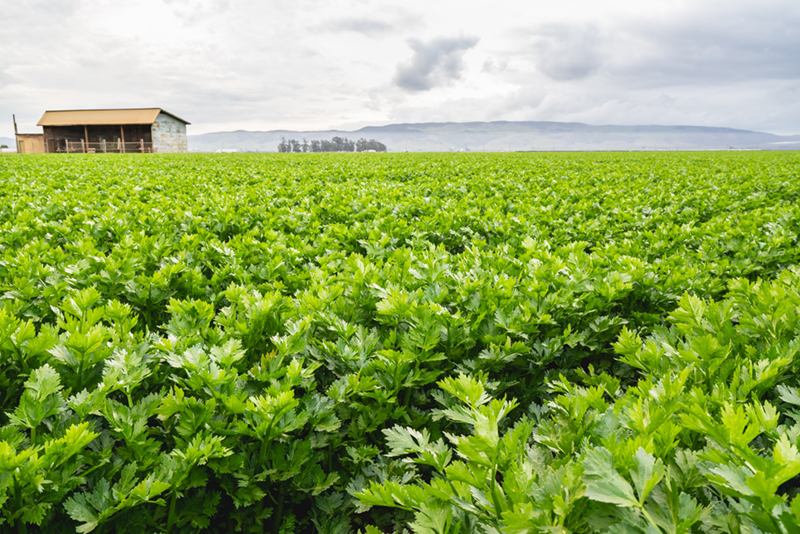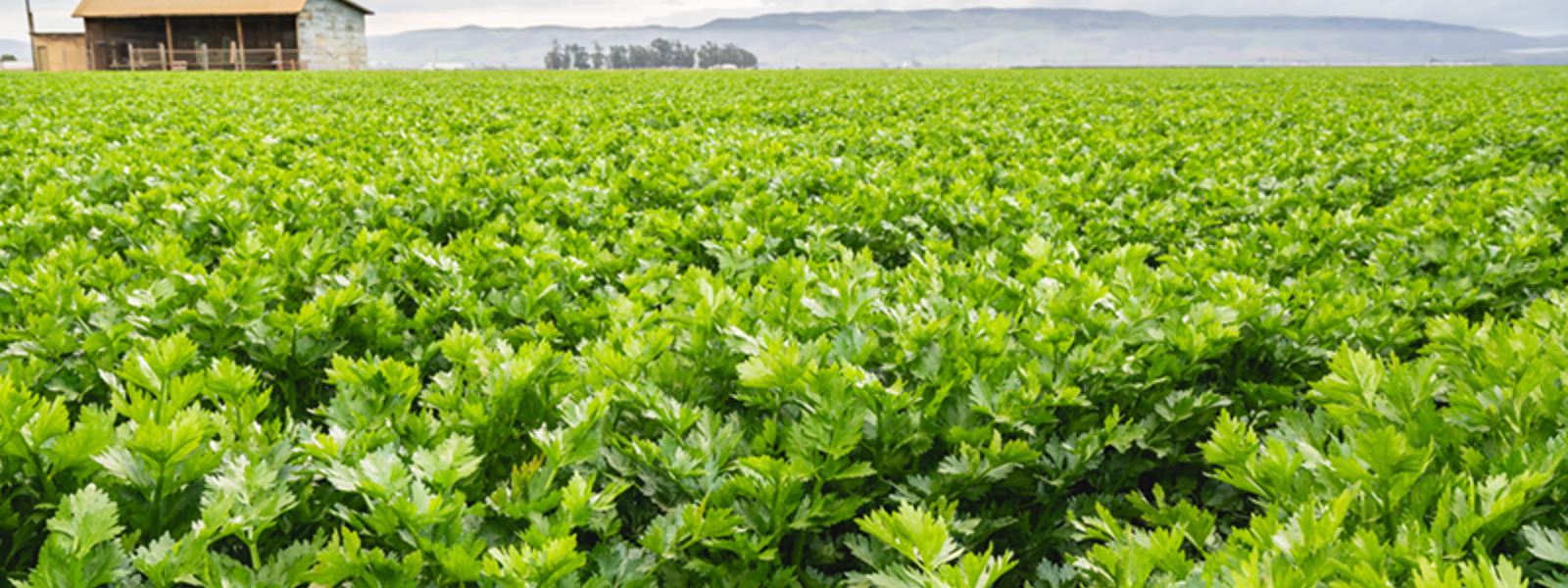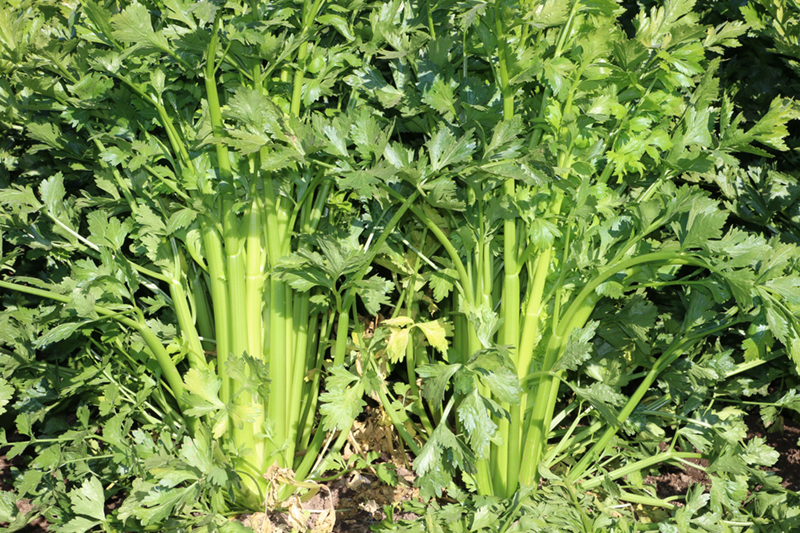Water needs vary in vegetables for nitrogen uptake

Celery grows on the Southern California coast. University of California researchers adjusted water-use recommendations for the crop to maximize nitrogen going to plants and minimize leaching.


Photo/Michael Cahn/University of California Cooperative Extension
By Rob McCarthy
Several years ago, a multi-agency team of researchers studied how water management decisions could help California celery and cabbage growers conserve groundwater and maximize the amount of nitrogen going to their crops.
The results were surprising. Growing celery required more water to maximize nitrogen uptake, which can also prevent nitrate loss to the atmosphere or into groundwater. With growing cabbage, adding more water diminished nitrogen uptake, researchers found.
Though never published, the findings from trials in Monterey County in 2018 and 2019 now influence irrigation practices by farmers. The study has informed water-use guidelines for vegetable growers who face state water-quality mandates to minimize nitrogen runoff.
The guidelines may be viewed at https://cropmanage.ucanr.edu, the University of California irrigation and nutrient-management website that combines weather, soil and irrigation data, and other variables to generate irrigation and fertilization recommendations based on crop-specific models.
Michael Cahn, a UC Cooperative Extension irrigation and water resources advisor in Monterey County, said the new recommendations were added because the trials showed that celery and cabbage behave differently when irrigation reaches 100% of the crop water needs based on real-time data.
“The celery, once we got to 100% to 150%, was maximizing nitrogen uptake. Going lower didn’t maximize it because doing that slows growth,” Cahn said during an Aug. 14 irrigation and water management session for vegetable and berry growers in Ventura County. “With the cabbage, nitrogen uptake drops off with more water, and if you underirrigated, the nitrogen didn’t drop off too much.”
During the Monterey County trials, researchers planted transplants on 135-foot by 16-foot sprinkler-irrigated beds. The team switched to drip irrigation after several weeks with 90% distribution uniformity. The plots were cultivated, harvested and analyzed. Researchers planted a second crop the following year. Nitrogen was applied before planting at a rate of 20 pounds per acre, and another 320 pounds per acre was applied during the season.
The effects of growth and nitrogen uptake were observed when 50% to 75% of the plant water needs weren’t met, Cahn said. Conversely, the team looked at the size and marketability of celery and cabbage when irrigation was boosted by 100% to 150% of the recommended evapotranspiration rate.
During the trials, celery plants at irrigation rates above 100% grew taller with fuller canopies. Even though the trials happened on a sandy loam plot in Salinas that isn’t considered celery soil, Cahn said, the plants produced stalks with good color, taste and a desirable texture.
“Basically, the more water you put on, the more growth you got,” Cahn said.
Based on the growth and nitrogen uptake observed in the summer trials, CropManage revised the weather-based calculation on celery water needs.
The target irrigation amount for the growing season is 17 inches. The previous irrigation target was 13.5 inches to meet 100% of a plant’s water loss during the growing season, Cahn said.
Andre Biscaro, a UCCE farm advisor in Ventura County, later conducted his own nitrogen and irrigation trial there. He recommends celery growers in the Oxnard area use 130% of the evapotranspiration rate, or ETo.
Such study results are getting renewed attention as local groundwater sustainability agencies are tasked with bringing depleted groundwater basins into balance under California’s Sustainable Groundwater Management Act.
In addition, the Central Coast Regional Water Quality Control Board requires growers to submit by March 2025 annual irrigation and nutrient management plans for minimizing nitrogen discharges to protect water quality.
While researchers increased the recommended celery irrigation rate for enhanced nitrogen uptake, Cahn cautioned growers at the Ventura County meeting that they should be careful to not overirrigate.
“The amount of water should be based on the weather and not just soil-moisture sensors,” he said.
Researchers say scheduling irrigation when the soil is already wet can lead to nitrate leaching in vegetables and berries.
California is the nation’s top producer and processor of celery, with an estimated 80% of the U.S. market, according to state and federal agricultural figures.
Ventura County’s celery farms brought in $168 million in earnings last year, according to the county’s crop report. Farms there planted 15,292 acres of celery last year.
Monterey County had 7,800 acres of celery in the most recent crop report for 2022. The commodity generated $174,000 in sales that year.
In terms of nutrient and irrigation management, the challenge for Central and South Coast celery and cabbage growers is to zero in on how much nitrogen is needed to grow and not exceed crop-specific amounts, said Jodi Switzer, the water program director for the Farm Bureau of Ventura County.
She said water-quality regulations are the biggest driver behind recommended nitrogen and fertilization management practices. She noted growers will be looking to farm advisors for research-based information on when and how much nitrogen to apply throughout the crop cycle.
“It’s critical that growers give a plant what it needs but not more and that it be applied when the crop needs it,” Switzer said.
(Rob McCarthy is a reporter in Ventura County. He may be contacted at robmccarthy10@yahoo.com.)




